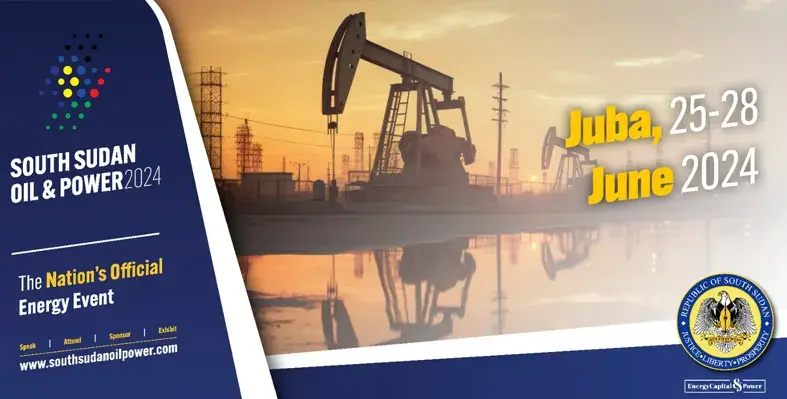Boasting an estimated 3.5 billion barrels of oil and producing an average of approximately 149,000 barrels per day (bpd) in 2023, South Sudan’s oil sector plays a vital role in the country’s economy. During the forecast period 2022-2027, South Sudan’s oil market is poised to grow at a compound annual rate of 1.5% - rising from 134,000 in 2021 to approximately 160,500 bpd by 2027.
Serving as the sole oil producing nation in East Africa, South Sudan is well-positioned to serve as a facilitator of investment, technology and expertise across the broader regional energy landscape. As such, the country will leverage this year’s South Sudan Oil & Power (SSOP) 2024 conference and exhibition to invite investors to explore and engage with opportunities across the upstream, refining, power generation and mining industries to drive projects and maximize oil production.Driving Upstream Investment
According to the Ministry of Petroleum – the regulatory body in charge of the country’s oil sector – nearly 90% of South Sudan’s oil and gas reserves remain untapped. As such, through the country’s parastatal Nile Petroleum Corporation (Nilepet), South Sudan aims to attract investment through ongoing or upcoming upstream licensing rounds to boost liquid fuels production for export and for domestic use.
South Sudan launched its first-ever licensing round in 2021, offering five exploration licenses to foreign investors in an attempt to accelerate exploration and production. With a total of 14 available blocks ranging between 4,000 and 25,000km2 in the Muglad Basin, which currently produces approximately 100,000 bpd, the licensing round is set to attract significant investor interest from international companies.
The Muglad Basin produces the highly attractive Nile crude oil blend at Blocks 1, 2A, 2B, 4 and 5A, which boasts medium waxy characteristics that are suitable for refining due to its high fuel and gasoil yields. Meanwhile, South Sudan’s Dar blend, which is a heavy crude oil with a low sulfur content, is produced at Blocks 3 and 7 in the Melut Basin. The country’s third blend, the Fula blend, is a highly acidic crude oil produced at Block 6 in the Muglad Basin, which is processed primarily for domestic use.
Increasing global interest
Major foreign oil companies in South Sudan’s oil sector are based in Asia, with the China National Petroleum Corporation (CNPC), India’s Oil and Natural Gas Corporation (ONGC) and Malaysia’s Petronas holding large stakes in the country’s petroleum industry.
The leading consortia operating in South Sudan’s oil sector include the Greater Nile Petroleum Operating Company (CNPC, 40%; Petronas, 30%; ONGC, 25%; Nilepet, 5%), the Dar Petroleum Operating Company (CNPC, 41%; Petronas, 40%; Nilepet, 8%; Sinopec, 6%; Tri-Ocean, 5%) and the Sudd Petroleum Operating Company (Petronas, 67.8%; ONGC, 24.2%; Nilepet, 8%).
In February 2024, upstream company Wildcat Petroleum passed a due diligence process in South Sudan, enabling the company to undertake petroleum deals in the country, including large-scale oil production purchases. According to the company’s Chairman Mandhir Singh, Wildcat Petroleum has been invited by the Ministry of Petroleum to visit Juba and enter discussions on current oil production opportunities.
Meanwhile, in June 2023, corporate social investment company the Strategic Fuel Fund (SFF) and Nilepet signed an agreement that will allow South Africa to use South Sudan’s geophysical plans to kick off exploration activities in the highly prospective Block B2 in the Muglad Basin. Under the six-year exploration period, the SFF and Nilepet will launch an aerogravity survey exploration, seismic acquisition and drilling campaign while investing in capacity building initiatives and infrastructure development projects.
Advancing midstream and downstream scope
South Sudan has one operational refinery - the Bentiu Refinery - which is situated in the northwest of the country and capable of producing approximately 7,000 bpd. In an effort to drive the country’s downstream capabilities, Nilepet is calling on investors to secure funding for the construction of an oil refinery in Block 5A. The project has amassed a total investment of $29 million, with the refinery’s estimated initial costs currently standing at $3 billion. Completion of the proposed refinery is expected to double the country’s oil production to 350,000 bpd while catering heavy fuel oil to potential markets in Kenya, Uganda and the Republic of the Congo.




